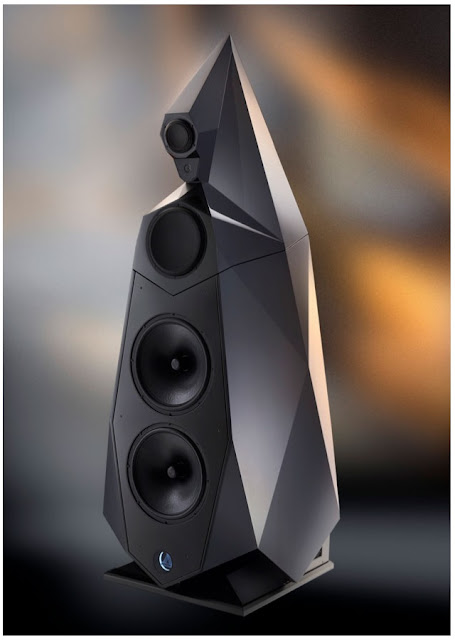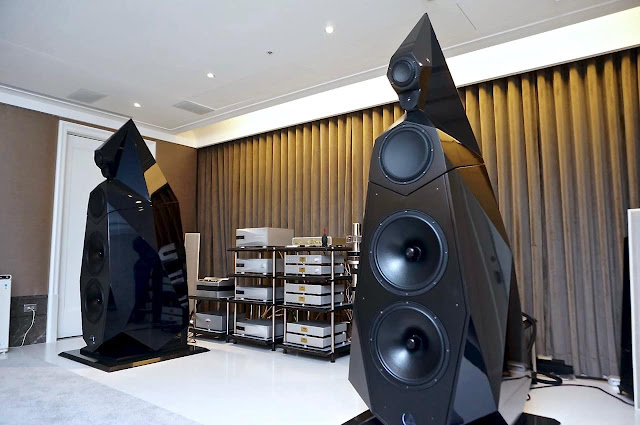Avalon Teseeract $327,000 Speakers with 4.5 Kilowatts per Channel
The appearance of Avalon Teseeract speakers is unusual - a complex case has many facets. This is the material embodiment of the concept of "tesseract", which is described in terms of mathematics and Stereometry.
Therefore, the task that Neil Patel, the main developer of the American company Avalon Acoustics, solved, was by no means trivial. His goal was to create acoustics capable of recreating the sound in the room, like at a live concert (symphonic, rock or chamber - it doesn’t matter) - so that not only the timbres of instruments, attack, “air”, but also the scale of sound images are accurately transmitted. And so that the speakers themselves are not perceived as a sound source, they must completely dissolve in the sound space. Other high-end hardware developers are also striving for the same. But not everyone does it in practice.
In the work of Patel, of course, there is a considerable share of creative inspiration, intuition, and intuition - all that is acquired with the experience of an engineer and an audiophile.
The word "tesseract" was coined by the English mathematician Charles Howard Hinton. As he believed, the three-dimensional world in which we live divides the four-dimensional world, inaccessible to our perception, into two parts: Ana (upper world) and Kata (lower). So a concrete slab divides the house into two floors.
So Neil Patel divided his flagship acoustics into two sections - upper and lower. It is supplied in four boxes with a total weight of 908 kg (the weight of each column assembled without packaging is 375 kg). The total height of the acoustic systems is 2.21m.
 |
| image credit: Avalon |
The meaning of the separation is clear: to minimize the influence of a powerful bass section on the midrange and high frequencies, to get a more rigid and stable design, and, finally, to make the product more transportable.
There are no parallel planes in the upper and lower parts - this is also understandable since internal standing waves are eliminated. And although there is not a single cube in the case, certain associations with the tesseract still arise - if you look at it from a certain angle, the square faces appear to be rhombuses
Neil Patel never does anything for nothing: every design and technical solution in his acoustics is carefully thought out and backed up by a fundamental scientific base. The complex shape of the column is not due to the designer's imagination, but to the movement towards the goal. Moreover, the design had to be partly sacrificed. So, due to the many versatile segments that form the surface of the case, they refused to finish the case with natural veneer.
The surfaces were first coated with a composite of carbon and fiberglass, which has excellent damping and shielding (due to the conductivity of carbon) properties, then polished, painted, polished again, covered with several layers of varnish and finished with a final polish.
It is not enough to formulate the ideal you are striving for - you need to know exactly what is needed to realize it. What properties acoustics should have and how to get them. These characteristics seem to be known to everyone, it is not difficult to achieve them individually, but they must be in the aggregate, but this is already much more difficult.
 |
| image credit: Avalon |
Say, getting the widest and most even frequency range is perhaps the easiest. Especially in the conditions of "uncompromising" design, when there are no rigid price limits. But there are other indicators without which the goal of complete realism of sound cannot be achieved: acoustics must work as a point source with minimal phase shifts and group delays. It is necessary to minimize intermodulation distortion, to achieve accurate focusing of sound images, to obtain the maximum dynamic range (i.e. the ability of acoustics to operate at high sound pressure levels without audible distortion)
It is also important to get the maximum response speed, a constant quality factor of the system over the entire frequency range, and a flat impedance line, practically free of reactive components, so that the acoustics are an easy load for the amplifier. A strictly defined radiation pattern is also very important.
The lower part of the range is fraught with the greatest problems, which is why the low-frequency section was made active. And also without compromise.
We chose an acoustic design that has all the advantages of a phase inverter, but without most of its shortcomings - a transmission line. It is not often used due to the complexity of the calculation and the laboriousness of production, but for Avalon Acoustics this is not an obstacle.
The rigidity of the hull is ensured not only by a powerful system of internal braces and braces but also by the very construction of many faces, the energy of each of which is transferred to the neighboring ones and is thus distributed throughout the structure - this principle is often used in modern architecture. In combination with the use of different materials and elements of different thicknesses, an inert, vibration- and resonance-free design is obtained. It also works to eliminate intermodulation distortion, as it minimizes the mutual influence of drivers on each other.
In the photo, we see two 15” bass drivers in each speaker, but in fact, there are four of them - they work in a proprietary isobaric configuration, that is, another pair of drivers is hidden inside. The speakers are not simple - they are characterized by a low-quality factor and a high power factor. Amplifiers - 3.2 kW per channel, operate in class AB, and are built on powerful MOSFET transistors.
The frequency range of the low-frequency section is from 13 to 70 Hz (at the level of -3 dB), the frequency of the section with the midrange / high-frequency section is 100 Hz. If we measure the characteristic with a tolerance of 0.5 dB, then the lower limit of the range is 16 Hz, this is the value indicated in the documentation.
The output of the lower and upper sections is equalized, however, it is possible to adjust the bass gain within +/- 2.5 dB in 0.25 dB steps. You can also select one of two bass section operation modes: Maximum Extension (maximally deep bass) or Transient Speed (best transient response). At the same time, as Avalon emphasizes, no DSP and digital transformations are used - a pure analog,.
In the "upper world" there are crossovers and three technologically expensive drivers: a midbass with an 11" diaphragm made of ceramic with a honeycomb structure, a midrange, also a 4.5" ceramic caliber and a unique 0.78" diamond tweeter with a special voice coil design.
Avalon Tesseract's overall frequency range is 16 Hz to 50 kHz, with a tolerance of +/- 0.5 dB (when measured in an anechoic chamber) or +/- 1 dB in a typical room. Sensitivity 93.5 dB (1 W @ 1 m), nominal impedance 6 ohms, minimum - 4 ohms (at 80 Hz). The recommended amplifier power is 15 - 500 watts.
As you can see, the characteristics are very worthy. But what is especially unique about Avalon acoustics for the Ultra High-End sphere is the parameters that few manufacturers specify: harmonic distortion of no more than 0.3% over the entire frequency range at a sound pressure of 93.5 dB; phase shifts between the speakers are not more than 3 degrees, also in the entire range; The group delay time is no more than 3 ms in the range of 16 Hz - 100 Hz and 1 ms in the range of 100 Hz - 20 kHz.
The "disappearance" of the speakers from the sound stage is provided by Stealth's proprietary technology, the essence of which is to control the scattering of sound waves in the room. The level and direction of radiation were calculated by the mathematical method of tensor fields.
The design of crossovers deserves a separate article. In short, their circuitry provides a low level of interference (this is necessary for the transmission of the "air" and the atmosphere of the room in which the recording was made), as well as the suppression of the back-EMF of the speakers. Of course, high-end components are used - hand-wound "air" coils and custom capacitors designed specifically for crossover filters.
 |
| image credit: Avalon |
Work on the Tesseract model lasted more than four years, although its release was preceded by a quarter of a century of research. Almost all systems released earlier (21 in total) were steps leading to the flagship.
It takes at least two months to make a pair of such speakers. It is impossible to organize their conveyor production. Six pairs are produced per year, one of which is intended for North America (the USA and Canada), and the rest disperse around the planet.
Avalon Teseeract Specifications:
System Performance:
Response: 16 Hz to 70 kHz (+/- 0.5 dB anechoic, +/- 1 dB in room response typical)
In-room low frequency response: (-1.5 dB @ 16Hz, -3 dB @ 13Hz typical, dependent upon room volume)
Efficiency: 93.5 dB (1 watt @ 1 meter)
Harmonic distortion: 0.30 % throughout the bandwidth at rated efficiency
Inter-driver phase deviation: 3 degrees within all cross bands
Noise floor: 68 dB from signal level (maximum noise level), 76dB Typical
Group delay distortion: 3 milliseconds 100 Hz to 16 Hz. 1 millisecond 100 Hz to 20 kHz.
Impedance: 6 ohms nominal (4 ohms minimum @ 80 Hz)
Recommended amplifier power: 15 to 500 Watts
Powered Isobaric Transmission Line Specs:
Power: 3.2 Kilowatts per channel
Automatic signal sensing and gain matching
Master Gain: +/- 2.5 dB (fixed resistor elements of 0.25 dB increments)
Toggle switch for selecting low-frequency contouring: Maximum extension or Transient Speed
Tempered-scale aperiodic tuning
Fully Analog symmetrical circuitry
No digital signal conversion or manipulation
Driver Complement (Per Channel):
4 x 15″ low Q high force factor sub-woofers
1 x 11″ ceramic/honeycomb underhung voice-coil midbass
1 x 4.5″ ceramic underhung voice-coil midrange
1 x .78 ” diamond underhung voice-coil tweeter
Physical Parameters:
Four independent cabinets, two per channel vertically integrated
Overall Height: 87″ (221 cm)
Width: 29″ (74 cm)
Depth: 32″ (82 cm)
Weight: 827 lbs. per channel (375 kilos), 1653 lbs. total (750 Kilos)
Shipping weight: 2002 lbs. (908 kilos)









0 Comments